 |
 |
 |
| |
Body Composition Changes in ARV-Naive Subjects Treated with Atazanavir or Atazanavir/Ritonavir-Based Once-Daily HAART:
96-Week CT and DEXA Data
|
| |
| |
Reported by Jules Levin
11th EACS, Oct 24-27, 2007, Madrid Spain
G.A. McComsey1, A. Rightmire2, V. Wirtz2, R. Yang2, M. Mathew2, D. McGrath2
1Division of Pediatric Infectious Diseases and Rheumatology, Case Western Reserve University, Cleveland, Ohio, USA;
2Research and Development, Bristol-Myers Squibb, Wallingford, Connecticut, USA
Note from Jules: in this study all patients received d4T in addition to 3TC plus either boosted or unboosted Reyataz. The mean decrease in limb fat from baseline to week 96 was -9% for patients taking ATV/r and -17% for patients taking ATV [p<0.001]; you could speculate that most of the limb fat loss at least in the boosted ATV group could be due to d4T suggesting little if any fat loss at week 96 due to ATV at least in the boosted ATV arm. More interesting findings in this study: VAT, visceral (belly fat) adipose tissue, increased the same in both groups, boosted and unboosted Reyataz, at week 96 from baseline; trunk fat also increased about the same amount in ATV and ATV/r; among women, mean limb fat increased by about 10% from baseline to week 96, while men had a mean loss; "Changes in fasting glucose, fasting insulin, fasting HOMA-IR, and weight were similar between the two regimens". See graphs and tables below. If you can't see pictures the full report will be posted to the NATAP website later today. Why is there more limb fat loss associated with unboosted ATV and these other unexpected differences between unboosted and boosted ATV. The authors don't have an answer but say more studies are needed to understand low-dose RTV in fat metabolism.
AUTHOR DISCUSSION
Lipoatrophy in HIV infection has a multifactorial etiology but NRTIs - particularly the thymidine analog d4T - contribute to the development of peripheral fat loss10,11
ACTG 5142 demonstrated that boosted PIs may protect against lipoatrophy while thymidine NRTIs are commonly associated with lipoatrophy12
At 96 weeks, body composition changes in the current study were similar overall between regimens (both containing d4T) and were consistent with the findings of other studies in naive patients
The change in trunk fat in both treatment arms at 96 weeks was similar to that which occurred at 48 weeks.13
However, at 96 weeks, there was a greater loss in limb fat in the ATV400 arm compared with that in the ATV300/RTV arm, suggesting that while there is little change in adipose tissue in the trunk, there is change in the limbs between 48 and 96 weeks
Temporal patterns of limb fat loss were consistent with those seen in previous studies of similar duration,8,14 with gains in limb fat in the first 12-24 weeks being followed by progressive losses over the ensuing 72-84 weeks
Only in the ATV400 group at 96 weeks was the decrease in limb fat statistically significant
ATV300/RTV was associated with significantly less lipoatrophy (defined as ≥20% loss of limb fat versus baseline) at 96 weeks compared with unboosted ATV (ATV300/RTV, 29%; ATV400, 49%; P < 0.05)
Nevertheless, there were few reports of clinical observations by patients or clinicians of lipoatrophy
Women had greater increases in VAT, SAT, TAT, and in trunk fat, than men at 96 weeks. Women in the boosted arm continued to have limb fat gain at Week 96
The greater propensity of HIV-infected women to develop adipose tissue abnormalities, compared with men, has been described previously15,16
AUTHOR CONCLUSIONS
In HIV-infected, ARV-naive subjects, after 96 weeks of treatment with RTV-boosted ATV or ATV regimens:
--Body composition changes were similar between regimens
-- The addition of RTV to ATV did not appear to result in an increased risk of trunk composition changes compared with unboosted ATV. However, in the limbs, ATV300/RTV was associated with significantly less lipoatrophy compared with ATV400
-- Additional studies to understand the potential role of low-dose RTV in fat metabolism and the meaning of gender differences in body composition are warranted
INTRODUCTION
Atazanavir (ATV), the first once-daily protease inhibitor (PI), is a recommended option for antiretroviral (ARV)- naive patients.1 It is generally well tolerated and has efficacy similar to efavirenz in this population2
PIs boosted with a subtherapeutic dose of ritonavir (RTV) are now preferred to unboosted PIs in the treatment of ARV-naive patients,1 although concerns have been raised about their potential for causing metabolic adverse events
ATV (boosted or unboosted) is less likely than other PIs to cause elevated lipid levels3,4 or to adversely affect insulin sensitivity5,6
BMS Study AI424089 was a randomized, open-label, multicenter, 96-week study designed to compare the efficacy and safety of RTV-boosted ATV (ATV300/RTV) with that of ATV (ATV400) in HIV-infected, ARV treatment-naive subjects
In the 96-week analysis of this study, virologic response rates were 75% and 70% (for ATV300/RTV and ATV400) and 65% and 55% (for ATV300/RTV and ATV400) for the <400 and <50 copies/mL (TLOVR analyses), respectively, which met the requirement for non-inferiority between the groups (non-inferiority: lower limit of the 95% confidence interval [CI] for the difference in virologic efficacy between the two treatment arms [ATV300/RTV and ATV400] was greater than -10%)7
Cross-section computerized tomography scanning (CT) and dual energy x-ray absorptiometry (DEXA) have confirmed clinical observations of lipodystrophy in patients on PI-based HAART.8 The current analysis reports body composition assessments by those two modalities and by lipodystrophy case definition (LCD) scores, and related lipid and metabolic changes through 96 weeks of treatment.
METHODS
In the 089 study, subjects were randomized to:
-- ATV 300 mg once a day (QD) + RTV 100 mg QD + lamivudine (3TC) 300 mg QD + stavudine (d4T) extended-release 100 mg QD or
-- ATV 400 mg QD + lamivudine (3TC) 300 mg QD + stavudine (d4T) extended-release 100 mg QD
Treated subjects had cross-sectional CT and DEXA scans at baseline and Weeks 24, 48, 72, and 96. Analyses were based on those who had paired CT and/or DEXA scans at baseline and Week 96
Visceral adipose tissue (VAT), subcutaneous adipose tissue (SAT), total adipose tissue (TAT), and fat (trunk, limb, and total body) were summarized by treatment regimen for subjects with Week 96 CT or DEXA pairs
Lipodystrophy case definition scores were used to determine patient and physician assessment of fat redistribution. These scores were derived from the Study of Fat Redistribution and Metabolic Change in HIV Infection (FRAM) survey9
Gender subgroup analyses were conducted on body composition data
Other assessments evaluated in this analysis included changes in weight, fasting lipids, glucose, insulin, and HOMA-IR
In a post-hoc analysis, subjects were classified as having lipoatrophy at a visit week if they had ≥20% loss of limb fat from baseline at that visit week
Treatment regimens were compared using the difference in mean percent changes from baseline at Week 96 for each CT/DEXA parameter (ATV300/RTV - ATV400) with 95% CIs and P values based on t tests
RESULTS
Demographics and Baseline Characteristics
Subjects (n = 129) were well matched between groups with respect to baseline characteristics (Table 1); these were consistent to those of all treated subjects (n = 199)
Table 1: Baseline Demographics of Treated Subjects With CT or DEXA Pairs
34% of participants are African-Americans in this sub-study, perhaps an analysis of this patient population would be interesting. Baseline weight is 68 and 69 kg, respectively in atv/r and atv arms; median baseline BMI is 23.9 and 23.8 kg, respectively; adipose tissue by CT, mean (cm2) for SAT is 183.4 and 212.2 for atv/r and atv, respectively, and for TAT is 267.6 for atv/r and 296.8 for atv. Body fat by DEXA, mean (kg) is for trunk-8.7 for atv/r and 9.9 for atv; for limb-7.7 for atv/r and 8.5 for atv; for total body fat is 17.2 for atv/r and 19.2 for atv.
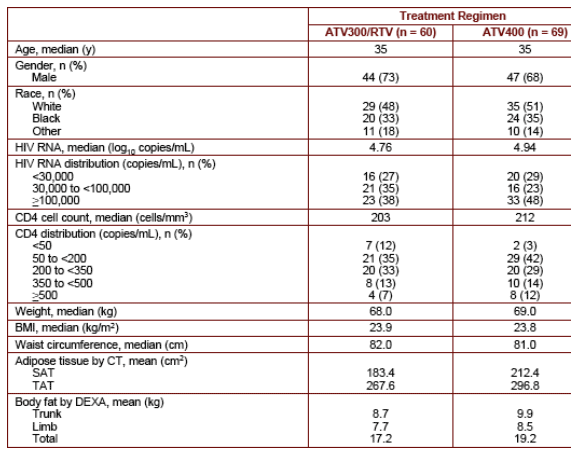
Adipose Tissue Changes
Subjects with paired CT scans on each regimen had similar and statistically significant mean percentage increases in VAT and TAT, but not SAT, at Week 96 from baseline, but there were no differences between arms (Figure 1)
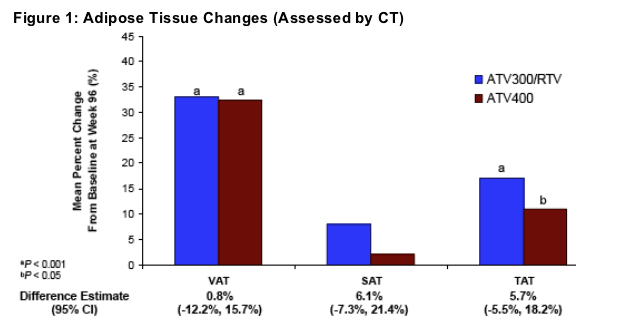
Statistically significant changes at Week 96 from baseline were seen in the ratios of visceral and subcutaneous fat compartments to total adipose tissue (Table 2) with no significant between-arm changes.

Body Fat Changes
Subjects with paired DEXA scans on each regimen had similar and statistically significant mean percentage increases from baseline in trunk fat at 96 weeks (ATV300/RTV, 16% [P < 0.05]; ATV400, 14% [P < 0.05]) (Figure 2)
Both groups had mean percentage decreases in limb fat (Figure 2), with the change being statistically significant for the ATV400 group (ATV300/RTV, -9%; ATV400, -17% [P < 0.001]), resulting in an increase in total body fat for the ATV300/RTV regimen (4%) and a decrease in total body fat for the ATV400 regimen (-1%)

By Week 96, significantly fewer subjects on the ATV300/RTV regimen than on the ATV400 regimen had developed lipoatrophy, defined as ≥20% loss of limb fat from baseline (ATV300/RTV, 29%; ATV400, 49%; P < 0.05) (Figure 3)
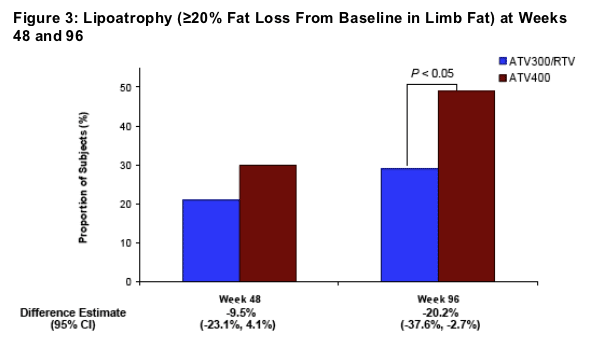
Lipodystrophy Case Definition Scores
In subjects with paired FRAM patient questionnaires at Weeks 12 and 96 (65 and 70 in the ATV300/RTV and ATV400 groups, respectively), subject-reported changes from baseline in various body compartments were consistent between regimens at Weeks 12 and 96:
At Week 96, most subjects in each treatment group
--Reported no change in face shape; the proportion reporting facial fat gain was similar to that reporting facial fat loss (∼10%-14%)
--Reported no change in arm fat; the proportion reporting arm fat gain was similar to that reporting arm fat loss (∼10%-16%)
--Reported no change or decrease in waist size. The proportion in each treatment group reporting an increase in waist size was ∼30%
In subjects with paired FRAM physician questionnaires at baseline and Week 96 (69 and 79 in the ATV300/RTV and ATV400 groups, respectively), investigator reported lipoatrophy and lipohypertrophy occurred in a minority of subjects and were similar between regimens at baseline and Week 96
--The percentage of subjects with lipoatrophy increased from 7% to 12% in the ATV300/RTV group and decreased from 13% to 6% in the ATV400 group
-- The percentage of subjects with lipohypertrophy increased from baseline with both treatments, but the percentage of subjects affected at 96 weeks was 14% in the ATV300/RTV group and 22% in the ATV400 group
Gender Differences
Within each regimen, females had larger mean percentage increases in VAT, SAT, and TAT at Week 96 from baseline (Figure 4)
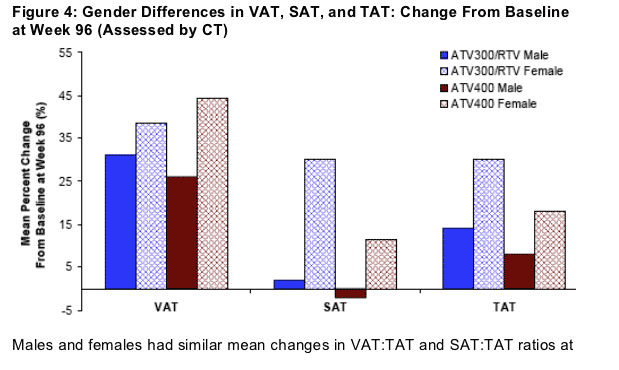
Males and females had similar mean changes in VAT:TAT and SAT:TAT ratios at Week 96 from baseline
Males on each regimen had larger mean changes in VAT:SAT ratios than females (ATV300/RTV: males 0.19, females 0.01; ATV400: males 0.16, females 0.08) due to the larger SAT increase observed in females
Within each regimen, females had larger mean percentage increases than males in trunk fat (assessment includes breast mass) at Weeks 48 and 96 from baseline (Figure 5)
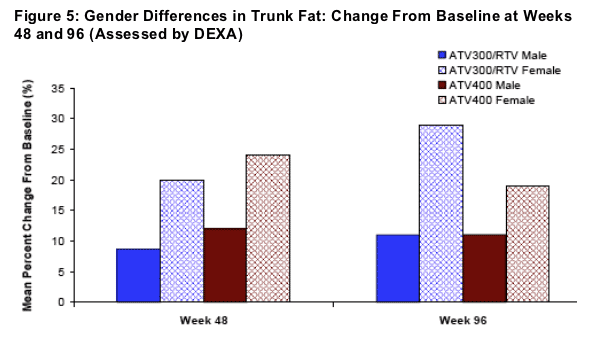
Males and females on both regimens had increases in limb fat at Week 24, with subsequent loss of some limb fat. By Week 96 there was a mean loss in limb fat compared to baseline, except for females on the ATV300/RTV regimen (Figure 6)
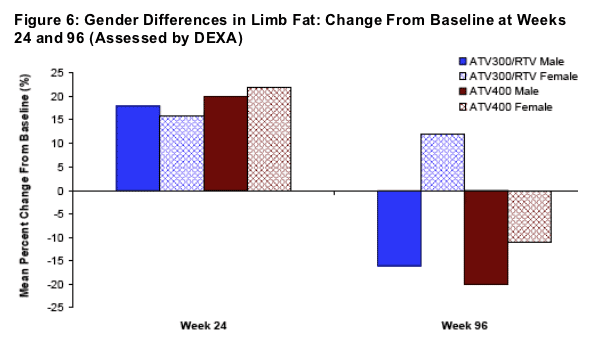
Lipid, Metabolic, and Weight Changes
Median lipid values at baseline and Week 96 are shown in Figure 7
Subjects on the two regimens had similar increases in lipids at Week 96 from baseline, and these results were similar to those seen in all treated subjects
A total of 11 subjects (6 on ATV300/RTV, 5 on ATV400) were on lipid-lowering therapy; one of them (in the ATV300/RTV group) was on since baseline. In lipid analyses, values were excluded after the start of serum lipid-reducing agents

aFor TC, LDL-C, TG, and non-HDL-C, the bar is normal/desirable level ± intervention level depending on other risk factors. For HDL-C, below the bar is the intervention level depending on other risk factors (NCEP ATP III Guidelines).
Changes in fasting glucose, fasting insulin, fasting HOMA-IR, and weight were similar between the two regimens (Table 3)
Changes in body mass index, waist circumference, and waist-to-hip ratios were negligible and similar between regimens

References
1. Hammer SM, Saag MS, Schechter M, et al. JAMA. 2006;296:827-843.
2. Squires K, Lazzarin A, Gatell JM, et al. J Acquir Immune Defic Syndr. 2004;36:1011-1019.
3. Murphy RL, Sanne I, Cahn P, et al. AIDS. 2003;17:2603-2614.
4. Johnson M, Grinsztejn B, Rodriguez C, et al. AIDS. 2006;20:711-718.
5. Noor MA, Parker RA, O'Mara E, et al. AIDS. 2004;18:2137-2144.
6. Noor MA, Flint OP, Maa JF, et al. AIDS. 2006;20:1813-1821.
7. Malan N, Krantz E, David N, et al. Presented at: 4th International AIDS Society Conference on HIV Pathogenesis and Treatment; July 22-25, 2007; Sydney, Australia.
8. Dube MP, Parker RA, Tebas P, et al. AIDS. 2005;19:1807-1818.
9. Tien PC, Benson C, Zolopa AR, et al. Am J Epidemiol. 2006;163:860-869. Epub 2006 Mar 8.
10. van der Valk M, Casula M, Weverlingz GJ, et al. Antivir Ther. 2004;9:385-393.
11. Joly V, Flandre P, Meiffredy V, et al. AIDS. 2002;16:2447-2454.
12. Haubrich RH, Riddler S, DiRienzo G, et al. Presented at: 14th CROI; February 25-28, 2007; Los Angeles, California. Abstract 38.
13. McGrath D, Frederick D, Wirtz V, et al. Presented at: 14th CROI; February 25-28, 2007; Los Angeles, California. Poster #N231.
14. Mallon PWG, Miller J, Cooper DA, et al. AIDS. 2003;17:971-979.
15. Galli M, Veglia F, Angarano G, et al. J Acquir Immune Defic Syndr. 2003;34:58-61.
16. Heath KV, Chan KJ, Singer J, et al. Int J Epidemiol. 2002;31:1016-1020.
|
| |
|
 |
 |
|
|